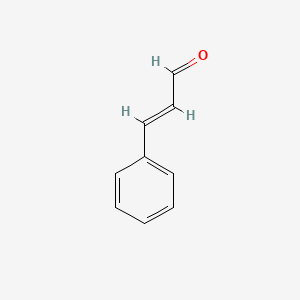Preparation of 4-(4'-methoxyphenyl)-3-buten-2-one (Product A)
A p-anisaldehyde (1.2mL, 10mmol) is prepared in acetone (15mL) in a
100mL round bottom flask. A magnetic flea is then added and the flask is
clamped over a magnetic stirrer. A potassium hydroxide (1.0 g) solution
in water (20mL) is prepared in a separate beaker and added gradually to
the mixture in the flask with continuous stirring for 20 minutes.
Now, around 40mL of water is added to the reaction mixture to
ascertain the precipitation of all products. The resulting solid is
filtered by vacuum filtration, followed by water washing. The solid is
then dried and recrystalized from ethanol (Figure 1).
Figure 1. Recrystallized 4-(4’-methoxyphenyl) but-3-en-2-one (Product A).
Figure 2 presents the
1H NMR spectrum
of p-anisaldehyde, clearly showing the resonances for the aldehyde and
oxymethyl proton environments. Inductive effects of the substituents are
considered to assign the two remaining resonances that belong to the
1,4-disubstituted benzene ring.
Figure 2. 1H NMR spectrum of p-anisaldehyde in CDCI3.
Figure 3. 1H NMR spectrum of 4-(4’-methoxyphenyl)-3-buten-2-one (Product A) in CDCI3.
The
1H NMR spectrum
of recrystallized 4-(4'-methoxyphenyl)-3-buten-2-one is presented in
Figure 3. The diagnostic methyl resonances at 3.83ppm and 2.35ppm belong
to the oxymethyl and terminal methyl at position 1on the aromatic ring,
respectively. The remaining resonances between 6.37- 7.69ppm represent
the lingering six protons under four chemical conditions. Assigning the
chemical shifts and multiplicities of these resonances is a complicated
process due to their overlapping. Detailed observation of this region is
carried out in the 2D J-resolved and COSY experiments (Figures 4 and
5).
Figure 4. 2D J-resolved spectrum of 4-(4’-methoxyphenyl)-3-buten-2-one (Product A) in CDCI3.
The 2D J-resolved experiment involves mapping of J-coupling constants
against the proton chemical shift, thereby allowing accurate
measurement of the chemical shifts of proton resonances through f2
dimension examination and their coupling constants in the fl dimension.
Spin-coupling partners, typically over 2-4 bonds, are identified in the
COSY experiment. Figure 5 presents the COSY of Product A, showing the
correlation among the same proton pairs determined in the 2D J-resolved
experiment by interpreting cross-peaks in the diagonal of the 2D
spectrum. The proximity among these resonances is further validated by
these correlations.
Figure 5. COSY spectrum of 4-(4’-methoxyphenyl)-3-buten-2-one (Product A) in CDCI3.





